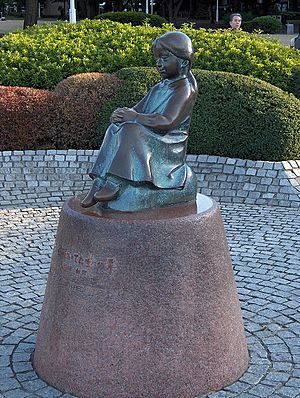Akai Kutsu facts for kids
Akai Kutsu (赤い靴, lit. "Red Shoes") is a Japanese nursery rhyme. It was written in 1922 by the Japanese poet Ujō Noguchi. The music was composed by Nagayo Motoori. The song tells the sad story of a little girl with red shoes who is taken away by a foreigner.
Contents
Song Lyrics
Here are the lyrics of "Akai Kutsu" and their English translation:
|
赤い靴(くつ) はいてた 女の子 異人(いじん)さんに つれられて 行っちゃった 横浜の 埠頭(はとば)から 汽船(ふね)に乗って 異人さんに つれられて 行っちゃった 今では 青い目に なっちゃって 異人さんの お国に いるんだろう 赤い靴 見るたび 考える 異人さんに 逢(あ)うたび 考える |
A young girl with red shoes |
A fifth part of the song was found later in 1978. It talks about the girl missing Japan.
|
生まれた 日本が 恋しくば |
When she misses Japan where she was born |
The Story Behind the Song
Many people believe the song is based on a true story. It is thought to be about a girl named Iwasaki Kimi. She was born in 1902 in Shizuoka Prefecture.
Kimi's mother, Kayo, was raising Kimi alone. Later, Kayo moved to Hokkaido and got married. When Kimi was three, her parents joined a farming group. Life on the farm was very hard.
So, Kayo decided to let an American missionary couple, the Hewitts, take care of Kimi. The Hewitts planned to go back to America. But Kimi became very sick with Tuberculosis, a serious illness at that time. Because of her illness, the Hewitts could not take Kimi to America.
Instead, they left Kimi at an orphanage in Azabu, Tokyo. Kimi sadly passed away there when she was nine years old. Her mother, Kayo, never knew this. Kayo believed that Kimi had gone to America with the missionaries.
How the Song Was Written
In 1907, the poet Ujo Noguchi met Kayo and her husband in Sapporo. Kayo told him the story of her daughter, Kimi, being taken away by missionaries. At the time, Kayo still thought Kimi was in America.
Years later, in 1921, Ujo Noguchi wrote the poem "Akai Kutsu." In 1922, it became a popular nursery rhyme with music by Motoori.
Finding the True Story
In 1973, Kimi's half-sister, Sono, wrote to a newspaper. She said that her sister was the girl from "Akai Kutsu." A reporter named Hiroshi Kikuchi from Hokkaido Television Broadcasting became interested. He spent five years researching the story.
In 1978, a TV show called "Document: The Girl in the Red Shoes" aired. It confirmed the story. Kikuchi also wrote a book about it. This book's story became the most accepted idea about the song's origin.
Different Ideas About the Song
Not everyone agrees with the established story. An author named Shousuke Ai believes parts of it might not be true. He wrote a book called "Hoax: The Unworn Red Shoes."
Ai's main points are:
- He thinks Kimi was given directly to the orphanage in Tokyo, not adopted by the Hewitts.
- He believes the Hewitts never met Kimi. He says Kimi's grandfather might have told Kayo that Kimi went with missionaries to comfort her.
- Ai also thinks that Ujo Noguchi and Kayo did not talk much. He doubts Kayo would have told Ujo about Kimi.
- Ai suggests that "Akai Kutsu" might be a symbol for problems in a social movement at the time, not about a real girl.
Hiroshi Kikuchi, the reporter, still believes his original story is correct. Ujo Noguchi's own son, Nobuya, also said that Ujo's nursery rhymes, including "Akai Kutsu," are not about any specific person. However, Ujo's granddaughter, Fujiko, believes some songs, like "Shabondama", are about real people.
Despite these different ideas, both sides agree on one thing: Kayo truly believed her daughter Kimi had gone to America. The main disagreement is whether the missionaries were real people (Kikuchi's theory) or just a made-up story (Ai's theory).
The debate continues, and no single answer has been fully agreed upon.
Other Interpretations
There have been other ideas about what "Akai Kutsu" means. Some people have suggested that the "red" in "Red Shoes" might have a hidden meaning related to politics. However, Ujo Noguchi himself once said that "it is not acceptable to critique a nursery rhyme's lyrics using logic." This suggests that the song should be enjoyed for its simple story and feelings, not over-analyzed for hidden messages.
Statues Honoring the Girl
Several statues have been built in Japan to remember Kimi and the song "Akai Kutsu."
- In 1979, a statue called "The Girl in the Red Shoes" was put up in Yamashita Park in Yokohama. It shows the innocent image from Ujo's poem.
- A smaller version of this statue was also placed at Yokohama Station.
- In 2009, a copy of the Yokohama statue was put in San Diego, California, which is a sister city to Yokohama.
Other statues based on the established story of Kimi include:
- "Mother and Daughter Statue" in Nihondaira, Shizuoka Prefecture (1986)
- "Statue of Kimi-chan" in Azabu-Juuban, Tokyo (1989)
- "Mother's Feelings" in Rusutsu, Hokkaido (1991)
- "Akai Kutsu: Parents and Child Statue" in Otaru, Hokkaido (2007)
- "Statue of Kimi-chan" in Hakodate, Hokkaido (2009)
- "Akai Kutsu Statue" in Ajigasawa, Aomori Prefecture (2010)
See Also
Images for kids



